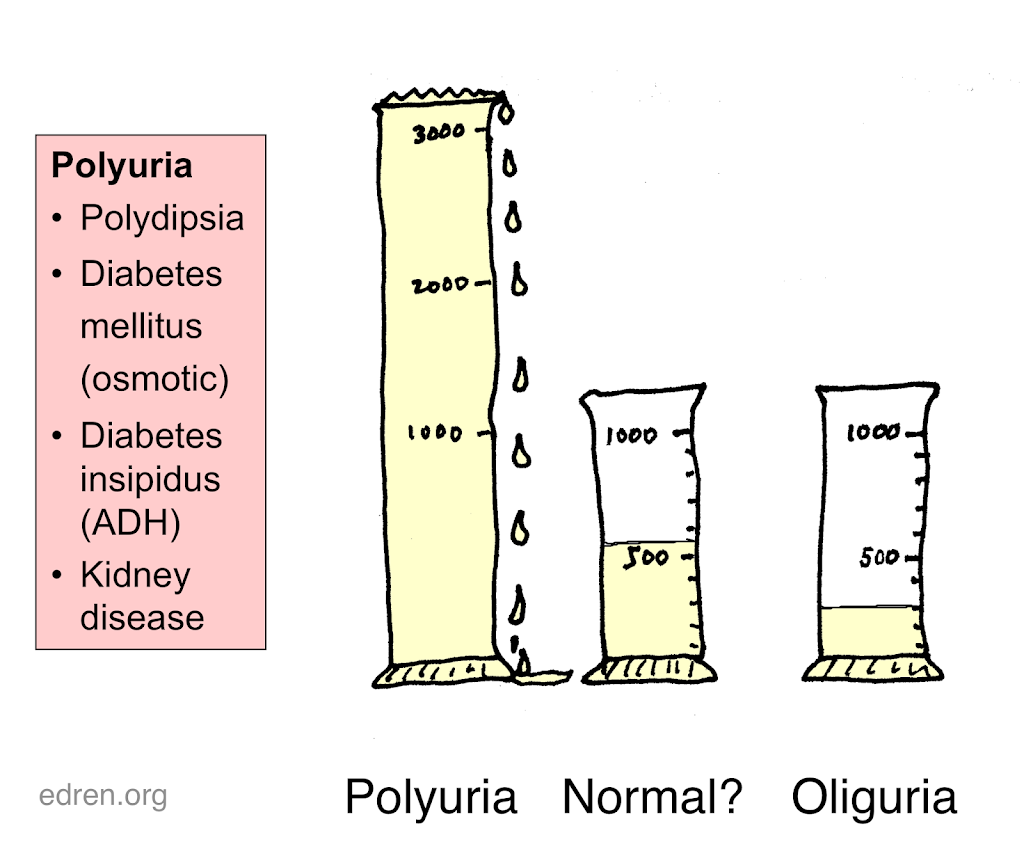A disease of 1769 becomes a treatment in 2015
The Edinburgh physician William Cullen described the difference between ‘sweet’ diabetes (mellitus = honey), and rare cases where the urine tasted ‘insipid’, in 1769. There were no dipsticks then, so the basis of distinction was indeed taste.
 |
| There is huge variation in how much people drink. But not so many causes of extreme polyuria. |
In 1792 two remarkable cases from the lay press (the Paris Journal in 1789, and Lincoln Mercury in 1791), were recounted in a medical journal. They were a French woman thirsty from birth, said to have drunk two buckets of water each day at the age of 3, and an English labourer whose polyuria came on after an infection when he was 31 and was estimated at well over 10 litres. They lived for years apparently well despite this – most unlike diabetes mellitus.
The pituitary gland and DI
Occasional head injuries and tumours suggested that something at the base of the brain could be responsible. Then in the 1890s came an experimental craze for injecting extracts of different organs to see what happens. Renin and thyroxine emerged from this activity, but further discoveries were that pituitary gland extracts could elevate blood pressure, cause the uterus to contract, and release milk. Findings on urine volume were at first contradictory, but by 1913 two groups confirmed that posterior pituitary extracts reduced urine volumes. At high (pharmacological) doses, hypertension could be produced. This gave rise to two names for the same hormone; anti-diuretic hormone (ADH), and vasopressin. The physiological importance of the brain in controlling urine volume was confirmed in experiments in dogs by Starling and Verney in the 1920s.
Therapeutic pituitary extracts
Extracts of pituitary gland from at least two manufacturers were in use for postpartum haemorrhage as early as 1911. In 1922 it was found that nasal administration worked to reduce polyuria in diabetes insipidus. However the use of extracts also revealed that some patients with diabetes insipidus did not respond to ADH – nephrogenic diabetes insipidus, as opposed to ‘cranial’. Familial occurrence of this was reported in 1947. Vasopressin, the name that has stuck, comes from a commercial posterior pituitary extract marketed in 1927.
Sequencing and synthesis
Vincent du Vigneaud won the Nobel Prize for Medicine in 1955 for determining the sequence of Oxytocin, and synthesising it chemically in 1953. He also synthesized Vasopressin in 1960, paving the way for Desmopressin, engineered to have a longer action.
A disease to treat a disease
Drugs to block the action of Vasopressin/ADH were developed originally as a treatment for over-production of ADH, causing hyponatraemia. They worked, but so does fluid restriction. Meanwhile in the 1990s it was shown that the messenger molecule cAMP was elevated in polycystic kidney cyst cells. Blocking Vasopressin (ADH) receptors reduced secretion of fluid by the cells. In 2003-4 vasopressin receptor blockers were shown to slow cyst growth in animal models, and the 2012 TEMPO study showed that Tolvaptan, an inhibitor of ADH/ Vasopressin, also slowed the progression of autosomal dominant PKD in patients.
Conclusion
An unavoidable effect of Tolvaptan is to make urine very dilute, and patients very thirsty and polyuric. So since 2016, nephrologists have been deliberately causing diabetes insipidus in some patients, whilst curing it in others.
Further Reading
Monkey glands and renal hypertension (this blog)
Breitstein LI, 1911. Use of Pituitrin in obstetrics. California State Journal of Medicine 9:490-1
Lindholm J, 2004. Diabetes insipidus: historical aspects. Pituitary 7:33-8
Eknoyan G, 2010. A history of Diabetes insipidus. Am J Kid Dis 56:1175-83 (full text is open access)
Torres VE et al, 2012. Tolvaptan in patients with autosomal dominant polycystic kidney disease. New Engl J Med 367:2407-18
[Anonymous] 1792. An account of two cases of polydipsia, or excessive thirst. Medical Facts and observations, London. 2:73-101 (Link to full book online)
William Cullen: Wikipedia; see also the Cullen Project, and eemec link (defunct, re-creation in progress). Others probably alluded to insipid diabetes around the same time, but his account was clear and thoughtful.
